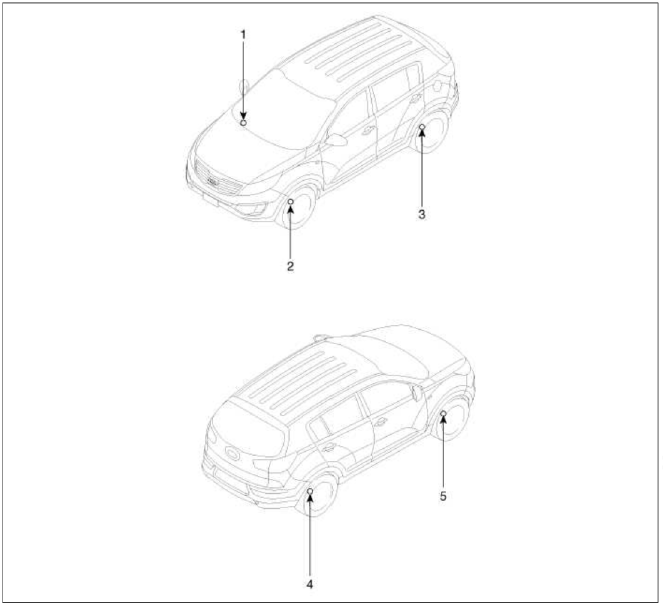Kia Sportage: Components and Components Location, Description and Operation
Kia Sportage Third generation (SL) - (2011-2016) - Service and Repair Manual / Suspension System / Tire Pressure Monitoring System / Components and Components Location, Description and Operation
Components and Components Location
Components Location

- Receiver
- TPMS Sensor
- TPMS Sensor
- TPMS Sensor
- TPMS Sensor
Description and Operation
Description
TREAD Lamp
- Tire Under Inflation / Leak Warning.

1. Turn on condition
- When tire pressure is below allowed threshold
- When rapid leak is detected by the sensor.
- Indicates that the needs to be re-inflated to placard pressure / repaired.
2. Turn off condition
- Under-inflation; When tire pressure is above (warning threshold + hysteresis).
- Rapid Leak; When the pressure is above (leak warning threshold).
DTC Warning
1. Turn on condition
- When the system detects a fault that is external to the receiver/ sensor.
- When the system detects a receiver fault.
- When the system detects a sensor fault.
2. Turn off condition
- If the fault is considered as 'critical', then the lamp is held on throughout the current Ignition cycle (even if the DTC has been de-activated). This is because it is important to bring the problem to the drivers attention. On the following Ignition cycle, the de-activated conditions will be re-checked. If the de-activate conditions occur, the lamp will be turned off. It will be held on until DTC demotion checking is completed.
- 'Non critical' faults are those that can occur temporarily e.g. vehicle battery under voltage. The lamp is therefore turned off when the DTC demotion condition occurs.
System Fault
1. General Function
- The system monitors a number of inputs across time in order to determine that a fault exists.
- Faults are prioritized according to which has the most likely cause.
- Maximum fault stored is equal to 15.
- Certain faults are not covered through DTC. The main ones are:
- Sensor thermal shutdown (over 257ºF/125ºC).
- Ignition Line stuck; requires observation of lamps at Ignition ON to diagnose.
READ NEXT:
 TPMS Sensor
TPMS Sensor
Description and Operation
Description
1. Mode
Configuration State
All sensors should be in the Low Line (Base) state.
In Low Line (Base) configuration, sensor transmissions occur e
 TPMS Receiver
TPMS Receiver
Components and
Components Location
Components
TPMS Receiver Circuit Diagram
Harness Connector
Battery
CAN_High
GND
-
-
-
IGN
CAN_Low
-
-
-
-
Description and
SEE MORE:
 Automatic turn off function
Automatic turn off function
This vehicle is equipped with lights
throughout the vehicle to illuminate the
interior.
CAUTION
Do not use the interior lights for
extended periods when the engine is not
running.
It may cause battery discharge.
WARNING
Do not use the interior lights when driving
in the dark. Accidents c
 Battery replacement
Battery replacement
The smart key uses a 3 volt lithium battery
which will normally last for several
years.
If you are
unsure how to use or replace
the battery, contact an authorized Kia
dealer.
Detach mechanical key from your
smart key.
Pry open the key cover.
Replace the smart key cover with a
Content
- Home
- Kia Sportage - Fifth generation (NQ5) - (2022-2026) - Owner's Manual
- Kia Sportage - Second generation (JEKM) (2005-2015) - Body Workshop Manual
- Kia Sportage Third generation (SL) - (2011-2016) - Service and Repair Manual
- Sitemap
- Top articles